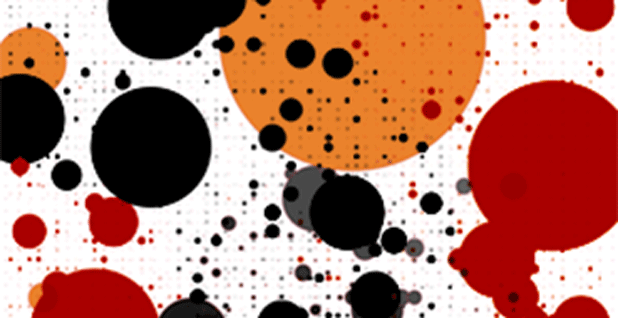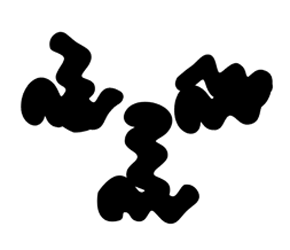A Platform of Noise, 2012
ABSTRACT: This paper reviews the trajectory of Glitch as an art practice, explores its language, and ruminates a path to guide its future.
The need to transmit information has never been in question. Information has been transferred by sign, hoof, cable and bit. The technology
has matured; it has graduated from semaphore, horseback, and the telegraph to the telephone, wi-fi, and the Internet to meet this constant
need. However, no matter the chosen mode of transmission or class of technology, the objective remains to preserve the quality and utility
of information from root to terminus.
During transmission, information follows a course whose propagation has been mapped by the Father of information theory, Claude Shannon.
An engineer and mathematician who worked at Bell Labs during WWII, Shannon devised a model of communication in which information,
transposed with bits, maintains its identity. Further development of his theory established a model through which the signal to noise
ratio of transmitted information could be measured. Although Shannon’s work focused on information transferred between machines, there
exists the requirement to conserve the integrity of information during human-to-human and human-to-machine communication as well. In
America, Verizon’s “Can you hear me now?”, AT&T’s “More bars in more places.” and, Apple’s “What can you do with Siri?” are corporate
promises that emphasize the requirement to transmit more signal and less noise.
The ultimate aim for the transmission of information is to achieve an error-free channel — free of interruptions, free of distortions
and, never random. However, while technology, industry and we expect to experience error-free communication, Glitch siphons the
transferred detritus, discards the signal and employs the noise.
Glitch, a genre that encompasses both music and visual art exhibits the evidence of imperfect systems, which is predisposed to be
concealed or eradicated. Glitch is a genre built upon an undesired property — a bug or an error — whose only perceived value rests in
its ability to indicate failure. Around this valueless entity, it erects an infrastructure to develop a medium from the discarded message.
A bug in a system no longer refers to the moth that found its way into the Mark II Aiken Ray Calculator’s Relay #70, Panel F, during
testing at Harvard University in 1947. When a bug reveals itself, it acts as an interruption, a shock to the system, which stops all
processes and throws an alert and propositions its user with options; as a strain on the system, which impedes all processes and withholds
it in suspended animation; as a switch, which terminates all processes — its state can only be resurrected upon reboot; or, as a
flag whose shocked user is confronted with a brilliant snapshot of a system’s failed synaptic relay — a flash, frozen or animated composition
of color or monochromatic geometric plates that represent the current physical condition of its memory, bits and bytes for varying lengths
of time. The later is fleeting in nature; it’s rare, elusive and random. The sparse glitch event is often captured, but occurs few and far
between. It is devoid of meaning other than context, which is fixed to the system failure.
As an art practice, Glitch questions authorship. The machine as creator is debatable. Made by the hands of man, human authorship of Glitch
can never be superseded by the machine. Regardless of who retains authorship of Glitch, the artist doesn’t participate in the creation of
an escaped thrown exception outside of the role as the system’s user. Additionally, the power to shock wanes with each successive glitch —
the expression of memory may change, but the novelty of the event is diminished. Breaking into the system to assume control over the glitch
becomes the creative endeavor.
Strategies aimed towards the direct access of a system’s internal infrastructure, databending, cracking video and audio codecs, manipulating
hex editors, creating new file formats and developing glitch software take control over the procedure initializing a deterministic process
where the result of a glitch remains indiscriminate. Still, the technical implementation of the simulated glitch achieves the aesthetic
similar to a native glitch whose result is the outcome of an internal computer malfunction. The value of the native glitch and the simulated
glitch, whose means of production differ, but share the same graphic and geometric visual language continues to be debated. The legitimacy of
a native glitch adds merit to Glitch for proponents of authenticity. The simulated glitch that only borrows the visual language of the native
glitch is but a work of abstract art. However, the value of authenticity remains unresolved. The provincial difference between the indigenous
and synthetic glitches, which share the same illusory impression, is imperceptible. The common denominator of the native and simulated glitch
is aesthetics, which forms the platform upon which Glitch rests.
The etymology of glitch is derived from the German glitschen, which means to slip. At first glance, the aesthetics of Glitch (derived from
the visual style of a native glitch) may appear to be a random presentation of color, lines, and shapes in arbitrary spatial concentrations.
Upon closer study, the aesthetics of Glitch reveal a composition of relationships that associate supposedly disparate components within a
total picture plane, static or animated. Traits consist of fragmentation, repetition, linearity, and complexity — horizontally or vertically
— woven throughout, which allude to the characterization of a slippage.
The novelty of the glitch event is no longer an indispensable ingredient to the identity of Glitch. The process of the creator, the
specifications of its generation supplant the context of a glitch divorced from a technological system malfunction. Still, the aesthetics,
an influential faculty, permeates this newly joined layer of embodiment. Glitch re-contextualizes the noise from the transmission of
information — the glitch event — as a visual impression. However, accepting Glitch primarily as an aesthetic veneer ignores the binary
nature of the recovered noise.
Shannon’s information theory specified two types of noise. The first being an external force composed from an inexplicable imbalance and
erratic function of a system. The second being entropy, which is composed and embedded within the transmitted information from its initial
point of departure. Entropy is a thermodynamic unit of measure, which quantifies a system’s tendency to fall apart, absolutely. Within the
context of Glitch, entropy establishes a relationship between the noise itself (represented by its visual or sonic aesthetic); the context
in which or, with which it is created (i.e. intent, narrative, process); and, the context in which it is presented (i.e. real-time, video,
spatial environment, physical manifestation).
Glitch, sans its layered taxonomy, reinforces the argument that the genre’s only worth is as an aesthetic surface treatment, which lacks the
sensorial power to move, unlock synesthetic properties or stimulate deep human emotion. Applied Glitch — glitch coupled with other media —
emboldens the genre. It embodies within its aesthetics the agency to encode context, which renders it sustainable. Coupled with narrative,
Glitch as a metaphor is awarded access to previously recognized language patterns and semiotics against which to judge its message. And,
coupled with the machine, Glitch both reflects and challenges the human relationship with technology, its role in current society, the
past and the future.
Glitch’s increasing taxonomy lowers the barrier to entry for viewers to understand and relate to work, which they are presented. Additional
layers of codification bridge the fracture between technology and humanity. Glitch, applied with respect to time, associates humans with
preservation, memory, life, death, past, present (including real-time), and future. Applied with respect to position, Glitch examines
proximity, texture, and location. Exploring volume within the context of occupied space and the context of sound, investigates the
interpretations of entropy beginning with its thermodynamic origins. And, applied with regard to perfection, Glitch scrutinizes the desire
to create and own perfectly replicated objects and seamlessly designed experiences.
Glitch originated with the machine. Work that represents the genre has the propensity to be presented from within it. As a result, a gap
between Glitch and the viewer is established. The mediated experience may allow an observer to sense the sights and sounds, which emanate
from a Glitch piece, but it may disallow the observer to experience it through touch. Viewing Glitch within an unmediated, shared space
resolves the dilemma with Glitch that lacks plasticity (i.e. live Glitch performance).
The expanding taxonomy of Glitch that helps viewers to learn and adapt its language and vernacular also enables them to recognize its
characteristics present in corresponding coordinate spheres: the human body, society, and culture. The breaks, malfunction, and errors
inherent in machines and other technological systems that cause glitches to ascend to the surface and reveal themselves in their visual
manifestations can be transposed to these alternative contexts while they maintain their identity as wayward packets of noise coupled with
their misdirected transmitted messages.
Perceived within the human body, a glitch can be expressed through behavior that threatens the status quo or, mutations that jut beyond the
accepted boundaries of what is considered normal. Glitches detected in society manifest themselves as discordant exhibitions of human behavior,
which when measured against the barometer of accepted social conventions of the collective, are deemed verboten. A societal glitch can also be
classified as resistance, a reaction that catalyzes a progressive movement in the opposite direction away from a more popular zeitgeist.
External to the machine, the connection between a glitch and its origins is tangentially repositioned, though the relationship between glitch
and its creator is analogous. The question of authorship shifts focus but remains. The existence of free will and the ownership of choice,
fault and personal responsibility can be attributed to an innate or acquired human glitch and be forgiven altogether. Whereas machines and
systems can trace a glitch back to the human hand by which it is built, mankind is without the freedom to do so. Arguments state that human
and societal glitches can be attributed to the circumstances of its birth, the hand by which is it raised and nurtured and, by nature and the
environment in which it is weaned. Wherever the answer lies, the judgment which rules upon the perfection of the being, of society and the mode
of responsibility glitch plays in relation, is at the mercy of the most powerful body by which they are governed.
Culturally, glitch is a function of its meaning in the context of humanity and society. It materializes as a signifier by which to define an
identity, a device to outwardly brand thoughts, actions, and standards. As the commodification of glitch continues to be enveloped within the
fabric of normality, glitch ceases to function as a construct upon which to broadcast participation in a social tribe. The message becomes
muddled and indecipherable, the environment too noisy for the message to stand out and present itself. The commodification of glitch strips
its language and confuses its vernacular. Glitch becomes a style, a fashion and is relegated once again to a surface aesthetic.
Glitch is an embodied medium progressing out of its infancy. It has been interpreted through a language and vernacular ascribed to its
technological origins. It has been applied within other contexts, which has widened its ability to communicate with man externally as
surface aesthetic or internally, reaching a deeper level through which it can emote. The growing vast and varied collection of Glitch
produced discloses the tapering fracture that exists between technology and humanity. Advances in technology will propel the practice of
Glitch forward. Unfamiliar glitches will emerge as new methods used to transmit information discard encrypted packets of noise to comprehend.
The drift towards the humanization of technology will not just narrow the gap between humanity and the machine but will work to overlap and unify
the two awarding Glitch a greater opportunity to detect novel glitches among mankind and society and to disseminate its language and vernacular
throughout culture. Advancements in manufacturing technology mirror the course to unify the human and machine although, this movement also allows
diminishing access to that technology. The distance by which the anatomy of the machine can be reached is only as far as the interface will
authorize. Glitch may have to look deeper and work harder to locate and exploit future glitches upon which to build onto its broadened platform
of language. However, no matter how deep or how hard the search may be, according to Shannon’s information theory, noise will always be present.









TrackBack URI